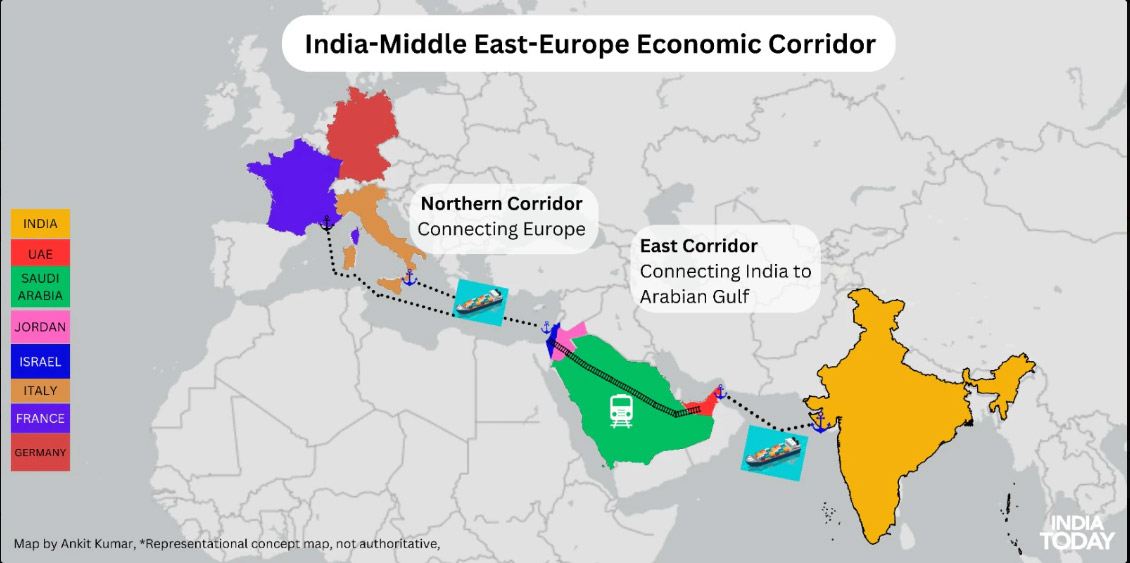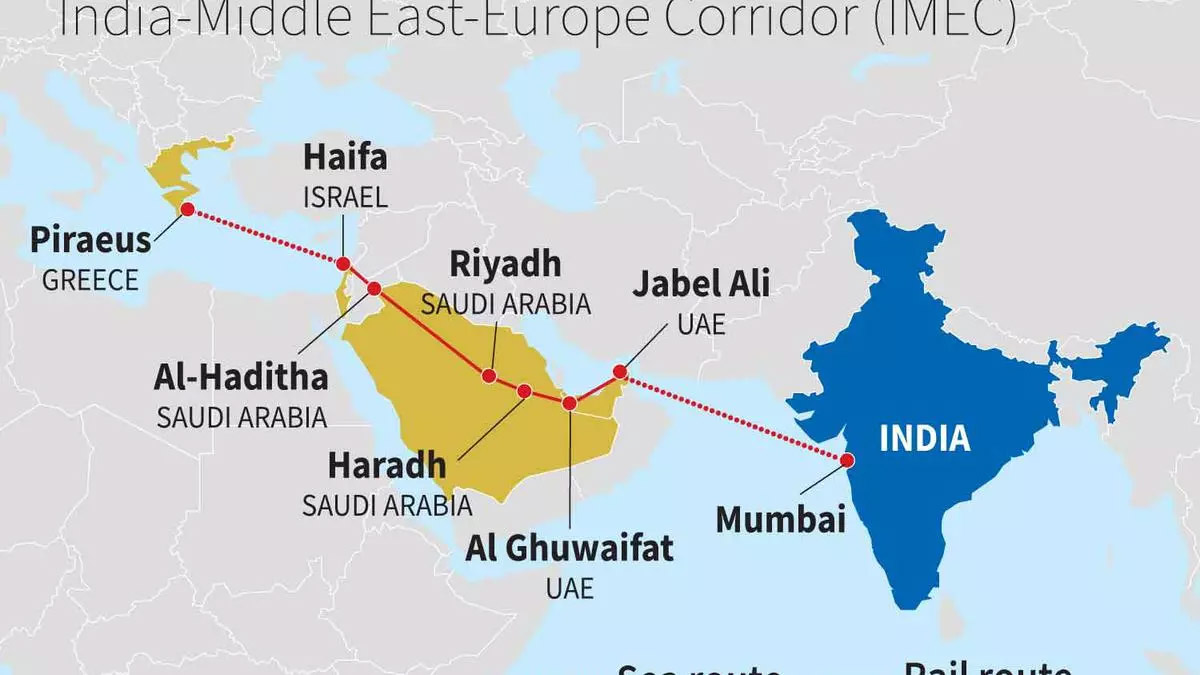
The G20’s IMEC Initiative: An Alternative Trade Corridor to China’s Belt and Road Initiative
September 21, 2023
The recent G20 summit in New Delhi witnessed the launch of a $20 billion India-Middle East-Europe Corridor (IMEC), an ambitious multi-pronged network aiming to connect goods and services between Europe and Asia—via the Middle East—more sustainably and efficiently. G20 countries involved in this initiative will hold a follow-up meeting to develop an action plan with defined timetables for implementation.
Alongside the practical economic and infrastructure benefits for the involved regions, IMEC aims to strengthen United States and EU leadership based on multilateral cooperation and prosperity across Eurasia and boost global supply chain solutions. Within this context, the G20-backed corridor seeks to constitute a geopolitical counterweight to China and its intercontinental Belt and Road Initiative (BRI), while checking Russia’s interconnectivity aspirations.
IMEC’s transport competent envisions a combined maritime-overland network that circumvents the existing maritime route via the Suez Canal: beginning with sea lanes connecting western India to the UAE, a rail network linking the UAE, the Kingdom of Saudi Arabia, Jordan and Israel, and culminating in a maritime route from Haifa to several European ports. The transport section is to be culminated by fiber-optic cables and a hydrogen pipeline spanning the 5,000-km route. In addition, the G20 envisions three complementary commercial-industrial corridors to IMEC in the fields of renewable energy, food security and the digital economy.
EU Commission President Ursula von der Leyen recently asserted that IMEC is forecast to reduce transport times and costs between the two locations by 30%-40%, a figure corroborated by some geopolitical analysts’ assessments. The project envisions a large role for the private sector in financing and constructing the infrastructure assets and creating untold numbers of new jobs while promoting a greener economy through greater energy efficiency and reduced carbon emissions.
IMEC’s inception at the G20 summit host country was fitting given the central role envisioned for India—which recently overtook China as the world’s most populous country and is forecast to be the third-largest consumer market by 2027—in anchoring this project’s feasibility. Placing New Delhi as a key node in IMEC is intended to cement its economic and diplomatic orientation towards the US-Europe camp and bolster its Indo-Pacific standing vis-a-vis Beijing. Additionally, IMEC represents an expansion of the US and India-led Partnership for Global Infrastructure and Investment (PGII), further spearheading India’s assertive leadership on the global stage. Looking ahead, India could leverage IMEC to enhance its transit hub role, such as by facilitating streamlined trade from Southeast Asia to the Middle East and Europe.
IMEC also serves to check Russian influence and overcome large-scale supply chain and logistics disruptions brought on by the invasion of Ukraine. As Europe eyes energy replacements for Russian gas and Middle Eastern countries seek to diversify food sources away from the Ukrainian-Russian conflict zone, IMEC has the potential to provide long-lasting remedies to these challenges. The G20-backed corridor also targets Russia’s proposed International North-South Transport Corridor to connect European markets to India via Iran, weakening the latter project’s viability and helping to encourage the maintenance of US-led international sanctions regimes against Moscow and Tehran.
Within the Middle East, IMEC advances regional connectivity and economic cooperation, as well as ties to the US and its European allies. Broadly speaking, the IMEC aims to undercut Chinese influence stemming from its sponsorship of Saudi-Iranian rapprochement and infrastructure investments in the region. The corridor additionally deepens Israel’s participation with neighboring Arab countries within the framework of the Abraham Accords, and likewise builds upon cooperation within the year-old I2U2 alliance (composed of Israel, India, the United States, and the UAE). Amid signals of growing Saudi-Israel engagement ahead of a possible normalization of relations, IMEC allows the two countries to indirectly cooperate in a multilateral forum, as well as other states without formal Israel ties. In fostering unprecedented infrastructure development and economic partnerships, IMEC can serve to strengthen regional security and political stability throughout the Middle East.
IMEC has the potential to be a quantum leap for Eurasian infrastructure connectivity, with US President Joe Biden labeling it “a game-changing regional investment” and EU Commission President Ursula von der Leyen calling it “the most ambitious project of our generation.” However, the plan does not come unopposed. Turkey’s President Tayyip Erdogan was quick to criticize the project, which bypasses his country, asserting that “there is no corridor without Türkiye.” He instead backs an alternative corridor, the Iraq Development Road Project, which proposes to connect the Gulf to Turkey and Europe via ports in the UAE, Qatar, and Iraq. Whether or not this opposition disrupts or can ultimately be incorporated into a modified IMEC vision remains to be seen.
As a multi-pronged trans-continental corridor, IMEC can be considered among the G20’s most far-reaching projects to date. In an age of ever-growing global financial uncertainty, supply chain challenges and diplomatic multipolarity, IMEC strives to reinforce a key long-term goal of the US-led intergovernmental forum—expanded trade and prosperity through mutual development, alongside preserving a commitment to a more sustainable world. That said, the corridor’s success will be tested by the practical challenges of cooperation among the multitude of participating countries, international organizations and business sector entities. Addressing issues such as sources of funding, infrastructure upgrades and synchronization, and bureaucratic procedures in relevant jurisdictions will be vital for the project to move forward. IMEC’s implementation can be expected to be informed by the feedback of key stakeholders at the table, including governments whose territory the project traverses and businesses involved in financing, building and maintaining the physical infrastructure. With these formidable challenges, the corridor could take years, if not decades, to become operational and will require firm unwavering backing from the involved players.

Courtesy of India Today and the Indian Administrative Service (IAS) blog https://blog.forumias.com/india-middle-east-europe-corridor-explained-pointwise/

Courtesy of the Hindu Business Line https://www.thehindubusinessline.com/opinion/a-corridor-of-immense-promise/article67296263.ece